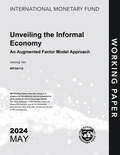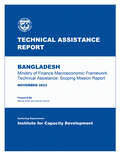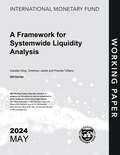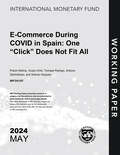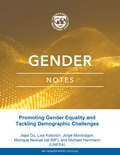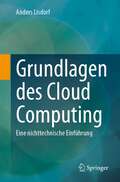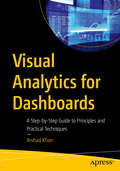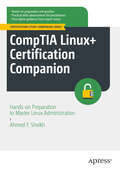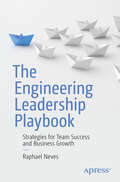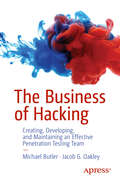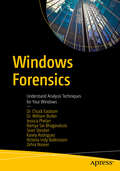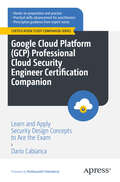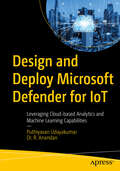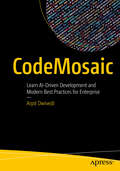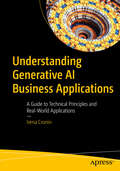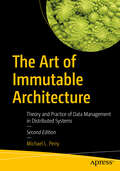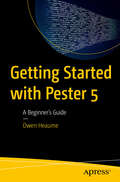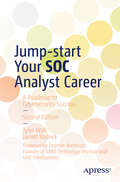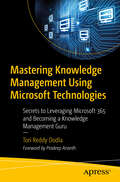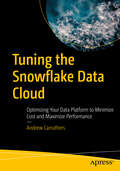- Table View
- List View
Unveiling the Informal Economy: An Augmented Factor Model Approach
by YaoA report from the International Monetary Fund.
Bangladesh: Technical Assistance Report-Ministry of Finance Macroeconomic Framework Technical Assistance: Scoping Mission Report
by International Monetary Fund. Institute for Capacity DevelopmentA report from the International Monetary Fund.
A Framework for Systemwide Liquidity Analysis
by ToffanoA report from the International Monetary Fund.
E-Commerce During COVID in Spain: One “Click” Does Not Fit All (Imf Working Papers)
by VazquezA report from the International Monetary Fund.
Rwanda: Third Reviews Under The Policy Coordination Instrument And The Arrangement Under The Resilience And Sustainability Facility, And The First Review Under The Standby Credit Facility Arrangement-press Release; And Staff Report (Imf Staff Country Reports)
by International Monetary Fund. African Dept.A report from the International Monetary Fund.
Exploring the Role of Public Expenditure in Advancing Female Economic Empowerment and Gender Equality (Imf Working Papers)
by EgererA report from the International Monetary Fund.
Do Renewables Shield Inflation from Fossil Fuel-Price Fluctuations?
by BeirneA report from the International Monetary Fund.
Gabon: Selected Issues (Imf Staff Country Reports)
by International Monetary Fund. African Dept.A report from the International Monetary Fund.
Promoting Gender Equality and Tackling Demographic Challenges
by HerrmannA report from the International Monetary Fund.
The Ritual: A Dark College Romance
by Shantel TessierBarrington University is home of the Lords, a secret society that requires their blood in payment. They are above all—the most powerful men in the world. They devote their lives to violence in exchange for power. And during their senior year, they are offered a chosen one. People think growing up with money is freeing, but I promise you, it’s not. My entire life has been planned out for me. I never got the chance to do what I wanted until Ryat Alexander Archer came along and gave me an option for a better life. He offered me what no one else ever had—freedom. I chose to be his. He made me believe that anyway, but it was just another lie. A way that the Lords manipulate you into doing what they want. After being sucked into the dark, twisted world of the Lords, I embraced my new role and allowed Ryat to parade me around like the trophy I was to him. But like all things, what started out as a game soon became a fight for survival. And the only way out was death.
Grundlagen des Cloud Computing: Eine nichttechnische Einführung
by Anders LisdorfUnabhängig davon, wo sich Ihr Unternehmen auf dem Weg in die Cloud befindet, ist der Wechsel in die Cloud in den kommenden Jahren unvermeidlich. Die Cloud wird kommen und bleiben, und jetzt ist der beste Zeitpunkt, um optimale Strategien zu entwickeln, um die Vorteile zu nutzen und die Risiken zu minimieren. Cloud Computing Basics ist der praktische, leicht zugängliche Einstiegspunkt, den Sie gesucht haben.Sie erhalten eine Einführung in die Grundlagen des Cloud Computing und in alle fünf großen Cloud-Plattformen. Der Autor Anders Lisdorf stellt sicher, dass Sie sich ein grundlegendes Cloud-Vokabular aneignen und lernen, wie Sie die von den verschiedenen Anbietern verwendeten Fachbegriffe übersetzen können. Die Nutzung der wirtschaftlichen und sicherheitstechnischen Vorteile, die die Cloud bietet, kann für jedes Unternehmen sehr unterschiedlich aussehen, und Lisdorf nutzt sein Fachwissen, um Ihnen zu helfen, Ihre Strategie entsprechend anzupassen.Grundlagen des Cloud Computing ist dazu da, Ihr Unternehmen in die Zukunft zu führen. Ganz gleich, ob Sie ein Anfänger auf diesem Gebiet sind oder eine technische Führungskraft, die den Wandel in Ihrem Unternehmen ankurbelt - dieses Buch bietet wichtige Einblicke in die Einführung der Cloud und ihre Vorteile für unser modernes digitales Zeitalter. Lassen Sie sich nicht abhängen und legen Sie sich die Grundlagen des Cloud Computing noch heute in Ihr Bücherregal.Was Sie lernen werdenVerstehen, was die Cloud ist und wie sie sich von herkömmlichen On-Premise-Lösungen unterscheidetSie erwerben ein grundlegendes Cloud-Vokabular und lernen, wie Sie es mit den Begriffen der verschiedenen Anbieter vergleichenSie kennen die wichtigsten Komponenten der Cloud und wissen, wie sie genutzt werdenSie kennen die Anbieter auf dem Cloud-Markt, ihre Stärken und Schwächen und wissen, was Sie von ihnen erwarten können.die optimale Cloud-Lösung auf den Unternehmenskontext abstimmenUntersuchung verschiedener Ansätze zur Cloud-Einführung und der Kontexte, in denen sie geeignet sind, damit Sie bestimmen können, wie Ihr Unternehmen den größten Nutzen aus der Cloud ziehen kannFür wen ist dieses Buch gedacht?Ein allgemeines Geschäftspublikum, das sich über die Grundlagen des Cloud Computing informieren möchte, um fundierte Gespräche mit technischen Fachleuten und Anbietern führen zu können. Das Buch richtet sich an alle, die ein tieferes Verständnis dafür entwickeln möchten, was die Cloud ist, woher sie kommt und wie sie sich in Zukunft auf jedes Unternehmen auswirken wird. Ein Grundverständnis der Informationstechnologie ist hilfreich, aber nicht erforderlich.
Visual Analytics for Dashboards: A Step-by-Step Guide to Principles and Practical Techniques
by Arshad KhanThis book covers the key principles, best practices, and practical techniques for designing and implementing visually compelling dashboards. It explores the various stages of the dashboard development process, from understanding user needs and defining goals, to selecting appropriate visual encodings, designing effective layouts, and employing interactive elements. It also addresses the critical aspect of data storytelling, examining how narratives and context can be woven into dashboards to deliver impactful insights and engage audiences. Visual Analytics for Dashboards is designed to cater to a wide range of readers, from beginners looking to grasp the fundamentals of visual analytics, to seasoned professionals seeking to enhance their dashboard design skills. For different types of readers, such as a data analyst, BI professional, data scientist, or simply someone interested in data visualization, this book aims to equip them with the knowledge and tools necessary to create impactful dashboards. What you’ll learn The principles of data visualization How to create effective dashboards Meet all the requirements for visual analytics/data visualization/dashboard courses Deepen understanding of data presentation and analysis How to use different kinds of tools for data analysis, such as scorecards and key performance indicators Who This Book Is For Business analysts, data analysts, BI professionals, end-users, executives, developers, as well as students in dashboards, data visualizations, and visual analytics courses.
CompTIA Linux+ Certification Companion: Hands-on Preparation to Master Linux Administration (Certification Study Companion Series)
by Ahmed F. SheikhThe CompTIA Linux+ Certification" book – the ultimate guide to mastering Linux system administration in preparation for the CompTIA Linux+ Certification. Whether you're a beginner or an experienced professional, this comprehensive resource is designed to equip you with the knowledge and skills needed to excel in the world of Linux.With its comprehensive coverage, this book delves into essential Linux concepts, commands, and techniques, providing you with a complete reference guide. You'll review how to customize and navigate the shell environment, write powerful scripts, configure user interfaces, perform administrative tasks, configure system services, establish network connections, and secure your system. No stone is left unturned in this in-depth exploration of Linux administration.What sets this book apart is its practical approach. Real-world scenarios and practical applications take center stage, ensuring that you not only understand the theory but also know how to apply it effectively.Troubleshooting common issues becomes second nature as you gain the skills to diagnose and resolve system problems with ease. You'll discover industry best practices and standards, enabling you to optimize systems, implement robust security measures, and adhere to compliance regulations.What You Will Learn:Linux operating systems, including installation, configuration, and management of Linux-based servers and systems. Essential administrative tasks, such as user and group management, file system administration, network configuration, and security implementation.Insights into troubleshooting common Linux issues, enabling readers to diagnose and resolve system problems effectively. Practical techniques for identifying and addressing system errors, performance bottlenecks, network connectivity issues, and other challenges that may arise in a Linux environment.Industry best practices and standards in Linux administration. System optimization, backup and recovery strategies, security practices, and adherence to compliance regulations.Who This Book is for:Administrators: This book serves as an excellent resource for individuals who are new to Linux administration and wish to develop a strong foundation in this field. They may have basic knowledge of Linux concepts or come from related IT roles and seek to expand their skills to include Linux system management.IT Professionals Transitioning to Linux: Professionals already working in the IT industry, such as system administrators or network engineers, who want to enhance their skill set and broaden their knowledge by incorporating Linux administration into their repertoire. They may have experience with other operating systems and are seeking to acquire Linux-specific skills.Experienced Linux Administrators: Seasoned Linux administrators can benefit from this book as well. It serves as a comprehensive reference guide, offering advanced topics, best practices, and insights into the latest trends and developments in the Linux ecosystem. It can be a valuable resource for expanding their expertise and staying up-to-date with industry standards.Secondary or tertiary audiences may include IT managers, system architects, or developers who work closely with Linux systems and wish to gain a deeper understanding of Linux administration. Additionally, students pursuing computer science or IT-related degrees may find the book beneficial for their coursework and career advancement.
The Engineering Leadership Playbook: Strategies for Team Success and Business Growth
by Raphael NevesIn today's business landscape, software engineering teams must deliver innovation faster than ever. However, outdated management approaches centered on tools and metrics rather than people strangle velocity and creativity. Legacy leaders cling to rigid structures mismatched with market dynamics, draining effort and morale from burnt-out teams. The Engineering Leadership Playbook provides a modern framework to unlock your team's potential through empathy, clarity, and empowerment. Unlike traditional leadership books fixated on delivery metrics, Raphael Neves offers a refreshing people-oriented leadership model tailored to nuances of engineering culture. With 15+ years leading high-growth tech teams, Raphael demystifies how to balance autonomy with alignment, reconstruct feedback models on psychological safety, and sustain excellence amidst uncertainty. You'll learn his proven conflict resolution blueprint for defusing clashes through mutual understanding while tangibly tracking progress. Additionally, his continuous feedback system grounded in evidence spotlights gaps early while accelerating strengths. This playbook moves systematically from foundational concepts like emotional intelligence and leading by example into team development frameworks around high-impact coaching, mentorship, and performance reviews. The method is brought full circle through innovation catalysts that maintain creative momentum at scale. Step-by-step, Raphael unpacks human-centered leadership aligned with accelerating market realities. Apply his engineering management playbook, and your teams will thrive fueled by vision, trust, and care. What You'll Learn Study different leadership styles and how to switch their approaches depending on circumstances Review critical communication skills, especially in technical fields Create IDPs for team members, especially senior engineers and leaders Who This Book Is For Current engineering leaders, aspiring engineering leaders, senior engineers, HR professionals and recruiters, and professionals in related fields
The Business of Hacking: Creating, Developing, and Maintaining an Effective Penetration Testing Team
by Michael Butler Jacob G. OakleyThere is a plethora of literature on the topic of penetration testing, hacking, and related fields. These books are almost exclusively concerned with the technical execution of penetration testing and occasionally the thought process of the penetration tester themselves. There is little to no literature on the unique challenges presented by creating, developing, and managing a penetration testing team that is both effective and scalable. In addition, there is little to no literature on the subject of developing contractual client relationships, marketing, finding and developing talent, and how to drive penetration test execution to achieve client needs. This book changes all that.The Business of Hacking is a one-of-a-kind book detailing the lessons the authors learned while building penetrating testing teams from the ground up, making them profitable, and constructing management principles that ensure team scalability. You will discover both the challenges you face as you develop your team of offensive security professionals and an understanding of how to overcome them. You will gain an understanding of the client’s requirements, how to meet them, and how to surpass them to provide clients with a uniquely professional experience. The authors have spent combined decades working in various aspects of cybersecurity with a focus on offensive cybersecurity. Their experience spans military, government, and commercial industries with most of that time spent in senior leadership positions. What you’ll learn How to handle and ongoing develop client relationships in a high end industryTeam management and how the offensive security industry comes with its own unique challenges. Experience in other industries does not guarantee success in penetration testing.How to identify, understand, and over-deliver on client expectations.How to staff and develop talent within the team.Marketing opportunities and how to use the pentesting team as a wedge for upsell opportunities.The various structures of services available that they may present to their clients. Who This Book Is For This book is written for anyone curious who is interested in creating a penetration testing team or business. It is also relevant for anyone currently executing such a business and even for those simply participating in the business.
Windows Forensics: Understand Analysis Techniques for Your Windows
by William Butler Chuck Easttom Jessica Phelan Ramya Sai Bhagavatula Sean Steuber Karely Rodriguez Victoria Indy Balkissoon Zehra NaseerThis book is your comprehensive guide to Windows forensics. It covers the process of conducting or performing a forensic investigation of systems that run on Windows operating systems. It also includes analysis of incident response, recovery, and auditing of equipment used in executing any criminal activity.The book covers Windows registry, architecture, and systems as well as forensic techniques, along with coverage of how to write reports, legal standards, and how to testify. It starts with an introduction to Windows followed by forensic concepts and methods of creating forensic images. You will learn Windows file artefacts along with Windows Registry and Windows Memory forensics. And you will learn to work with PowerShell scripting for forensic applications and Windows email forensics. Microsoft Azure and cloud forensics are discussed and you will learn how to extract from the cloud. By the end of the book you will know data-hiding techniques in Windows and learn about volatility and a Windows Registry cheat sheet.What Will You LearnUnderstand Windows architectureRecover deleted files from Windows and the recycle binUse volatility and PassMark volatility workbenchUtilize Windows PowerShell scripting for forensic applicationsWho This Book Is ForWindows administrators, forensics practitioners, and those wanting to enter the field of digital forensics
Google Cloud Platform: Learn and Apply Security Design Concepts to Ace the Exam (Certification Study Companion Series)
by Dario CabiancaWritten in a simple and developer-focused style, this book gives you the tools and knowledge you need to ace the GCP Professional Cloud Security Engineer certification exam. The approach is two-fold: introducing and implementing all GCP cloud security concepts and controls based on the certification exam objectives, and demonstrating how these concepts can be applied to real-world scenarios. Your study begins with cloud identities in GCP and different identity types (user accounts, service accounts, groups, and domains) and how separation of duties is implemented with access controls and Identity and Access Management (IAM). Emphasis is placed on the unique GCP approach to managing resources, with its clear distinction between resource ownership and resource billing. Following the defense in depth principle, the book shifts focus to network security and introduces different types of constructs that enable micro-segmentation, as they are implemented in a software-defined network. A chapter devoted to data protection is included. You will learn how to leverage the Data Loss Prevention (DLP) application programming interface (API) to prevent access to your workloads’ sensitive data from unauthorized use. Examples on how to use the DLP API are provided using the Go language, which is becoming widely adopted in the developer community due to its simplicity, and high-performance networking and multi-processing capabilities. Encryption at rest, in use, and in transit is covered with an overview on how GCP implements confidential computing. The book concludes with an examination of the GCP services you need to know to monitor, audit, and ensure compliance with the laws and regulations where your workloads and infrastructure operate. By the end of the book, you will have acquired the knowledge and confidence to pass the GCP Professional Cloud Security Engineer certification exam and to successfully design, architect, and engineer security solutions with the Google Cloud Platform. Bonus Material: IAM deny policies What You Will Learn Understand the five security principles and how to use them to drive the development of modern security architectures in Google Cloud Secure identities with Cloud Identity and Identity & Access Management (IAM) Secure the network with segmentation and private connectivity Protect sensitive data with the Data Loss Prevention (DLP) API and encryption Monitor, log, audit, and troubleshoot security incidents with the Google Cloud Operations Suite Ensure compliance and address regulatory concerns Who This Book Is For Software engineers specializing in DevOps, SecOps, and DataOps, who possess expertise in the Software Development Life Cycle (SDLC) methodologies within Agile teams. It also targets software architects with proficiency in various domains such as security, network, solution, data, infrastructure, cloud, and enterprise architecture.
Design and Deploy Microsoft Defender for IoT: Leveraging Cloud-based Analytics and Machine Learning Capabilities
by Puthiyavan Udayakumar Dr. R. AnandanMicrosoft Defender for IoT helps organizations identify and respond to threats aimed at IoT devices, increasingly becoming targets for cyberattacks. This book discusses planning, deploying, and managing your Defender for IoT system. The book is a comprehensive guide to IoT security, addressing the challenges and best practices for securing IoT ecosystems.The book starts with an introduction and overview of IoT in Azure. It then discusses IoT architecture and gives you an overview of Microsoft Defender. You also will learn how to plan and work with Microsoft Defender for IoT, followed by deploying OT Monitoring. You will go through air-gapped OT sensor management and enterprise IoT monitoring. You also will learn how to manage and monitor your Defender for IoT systems with network alerts and data. After reading this book, you will be able to enhance your skills with a broader understanding of IoT and Microsoft Defender for IoT-integrated best practices to design, deploy, and manage a secure enterprise IoT environment using Azure.What You Will LearnUnderstand Microsoft security services for IoTGet started with Microsoft Defender for IoTPlan and design a security operations strategy for the IoT environmentDeploy security operations for the IoT environmentManage and monitor your Defender for IoT SystemWho This Book Is ForCybersecurity architects and IoT engineers
CodeMosaic: Learn AI-Driven Development and Modern Best Practices for Enterprise
by Arpit DwivediThis book is a comprehensive guide for those navigating through the complexities of enterprise software development. For fresh graduates, transitioning from college projects to real-world applications can be overwhelming. This book acts as a roadmap, helping you bridge the gap to become industry-ready. It's like an intensive internship in book form, equipping readers with the skills and knowledge needed for modern tech roles. But it's not just for newcomers. Even experienced developers can get caught up in old routines and miss out on new tools and techniques. With the rise of AI and automation tools like ChatGPT and Copilot, the development landscape is rapidly changing. The core of the book revolves around practical application. Using .NET, Angular, and other Microsoft technologies as foundational pillars, you’ll embark on a hands-on journey. From understanding the basics to designing and deploying a full-stack web application, CodeMosaic offers a holistic learning experience. By the end, you won't just be a developer; you'll be well-equipped to tackle the challenges of today's digital world. What You'll Learn Review Agile methodologies and Azure DevOps for streamlined project management. Gain a thorough understanding of smart development from design to deployment. Master software development with .NET and Angular, along with effective version control using Git. Enhance your coding and design skills using GitHub Copilot, GPT technologies, and AI-driven prompt engineering. Who This Book Is For Experienced developers looking for new tools and techniques, and recent graduates, transitioning from college projects to real-world applications.
Understanding Generative AI Business Applications: A Guide to Technical Principles and Real-World Applications
by Irena CroninThis guide covers the fundamental technical principles and various business applications of Generative AI for planning, developing, and evaluating AI-driven products. It equips you with the knowledge you need to harness the potential of Generative AI for enhancing business creativity and productivity.The book is organized into three sections: text-based, senses-based, and rationale-based. Each section provides an in-depth exploration of the specific methods and applications of Generative AI. In the text-based section, you will find detailed discussions on designing algorithms to automate and enhance written communication, including insights into the technical aspects of transformer-based Natural Language Processing (NLP) and chatbot architecture, such as GPT-4, Claude 2, Google Bard, and others. The senses-based section offers a glimpse into the algorithms and data structures that underpin visual, auditory, and multisensory experiences, including NeRF, 3D Gaussian Splatting,Stable Diffusion, AR and VR technologies, and more. The rationale-based section illuminates the decision-making capabilities of AI, with a focus on machine learning and data analytics techniques that empower applications such as simulation models, agents, and autonomous systems.In summary, this book serves as a guide for those seeking to navigate the dynamic landscape of Generative AI. Whether you’re a seasoned AI professional or a business leader looking to harness the power of creative automation, these pages offer a roadmap to leverage Generative AI for your organization’s success.What You Will LearnWhat are the technical elements that constitute the makeup of Generative AI products?What are the practical applications of Generative AI?How can algorithms be designed to automate and improve written communication?What are the latest Generative AI architectures and algorithms?Who This Book Is ForData scientists, data analysts, decision makers, and business executives interested in gaining an understanding of Generative AI products
The Art of Immutable Architecture: Theory and Practice of Data Management in Distributed Systems
by Michael L. PerryThis book teaches you how to evaluate a distributed system from the perspective of immutable objects. You will understand the problems in existing designs, know how to make small modifications to correct those problems, and learn to apply the principles of immutable architecture to your tools.Most software components focus on the state of objects. They store the current state of a row in a relational database. They track changes to state over time, making several basic assumptions: there is a single latest version of each object, the state of an object changes sequentially, and a system of record exists.This is a challenge when it comes to building distributed systems. Whether dealing with autonomous microservices or disconnected mobile apps, many of the problems we try to solve come down to synchronizing an ever-changing state between isolated components. Distributed systems would be a lot easier to build if objects could not change.After reading The Art of Immutable Architecture, you will come away with an understanding of the benefits of using immutable objects in your own distributed systems. You will learn a set of rules for identifying and exchanging immutable objects, and see a collection of useful theorems that emerges and ensures that the distributed systems you build are eventually consistent. Using patterns, you will find where the truth converges, see how changes are associative, rather than sequential, and come to feel comfortable understanding that there is no longer a single source of truth. Practical hands-on examples reinforce how to build software using the described patterns, techniques, and tools. By the end of the book, you will possess the language and resources needed to analyze and construct distributed systems with confidence. The assumptions of the past were sufficient for building single-user, single-computer systems. But aswe expand to multiple devices, shared experiences, and cloud computing, they work against us. It is time for a new set of assumptions. Start with immutable objects, and build better distributed systems.What You Will LearnEvaluate a distributed system from the perspective of immutable objects Recognize the problems in existing designs, and make small modifications to correct them Start a new system from scratch, applying patternsApply the principles of immutable architecture to your tools, including SQL databases, message queues, and the network protocols that you already use Discover new tools that natively apply these principles Who This Book Is ForSoftware architects and senior developers. It contains examples in SQL and languages such as JavaScript and C#. Past experience with distributed computing, data modeling, or business analysis is helpful.
Getting Started with Pester 5: A Beginner's Guide
by Owen HeaumeEmbark on a transformative journey into the world of Pester and elevate your PowerShell scripting to new heights of robustness, reliability, and efficiency. This comprehensive beginner's guide provides a hands-on approach to PowerShell testing using Pester, empowering you to enhance your code quality with confidence.The book starts with an introduction to Pester, the powerful testing and mocking framework for PowerShell. You'll gain a solid foundation by exploring Pester's fundamental building blocks. The book guides you through the phases of Pester, helping you write your initial Pester code. You will dive into topics such as tags, assertions with Should and parameter filters, and you will explore advanced techniques such as Test Drive and Test Registry.You will discover the art of mocking in Pester and master its advanced testing methodologies. You will gain insights into working without installed modules and seamlessly integrating Pester with Azure DevOps Pipeline for a streamlined testing process.After reading this book, you will have the knowledge and skills to initiate your own exploration into PowerShell testing with Pester. You will transform your scripts into reliable powerhouses, ensuring the resilience and quality of your PowerShell code.What Will You LearnBuilding blocks and phases of PesterWriting effective Pester testsAssertions, mocking, and advanced testing techniquesIntegration with Azure DevOpsTags, code coverageWho This Book Is ForPowerShell scripters and Pester Framework beginners
Jump-start Your SOC Analyst Career: A Roadmap to Cybersecurity Success
by Tyler Wall Jarrett RodrickThe frontlines of cybersecurity operations include many unfilled jobs and exciting career opportunities.A transition to a security operations center (SOC) analyst position could be the start of a new path for you. Learn to actively analyze threats, protect your enterprise from harm, and kick-start your road to cybersecurity success with this one-of-a-kind book. Authors Tyler E. Wall and Jarrett W. Rodrick carefully and expertly share real-world insights and practical tips in Jump-start Your SOC Analyst Career. The lessons revealed equip you for interview preparation, tackling day one on the job, and setting long-term development goals.This book highlights personal stories from five SOC professionals at various career levels with keen advice that is immediately applicable to your own journey. The gems of knowledge shared in this book provide you with a notable advantage for entering this dynamic field of work. The recent surplus in demand for SOC analysts makes Jump-start Your SOC Analyst Career a must-have for aspiring tech professionals and long-time veterans alike. Recent industry developments such as using the cloud and security automation are broken down in concise,understandable ways, to name a few. The rapidly changing world of cybersecurity requires innovation and fresh eyes, and this book is your roadmap to success. New to this edition: This revised edition includes three entirely new chapters: Roadmap to Cybersecurity Success, The SOC Analyst Method, and ChatGPT for SOC Analysts. In addition, new material includes a substantially revised Cloud chapter, revised pre-requisite skills, and minor revisions to all chapters to update data. What You Will Learn • Understand the demand for SOC analysts • Know how to find a SOC analyst job fast • Be aware of the people you will interact with as a SOC analyst • Be clear on the prerequisite skills needed to be a SOC analyst and what to study • Be familiar with the day-to-day life of a SOC analyst, including the tools and language used • Discover the rapidly emerging areas of a SOC analyst job: the cloud • and security automation • Explore the career paths of a SOC analyst • Discover background-specific tips for your roadmap to cybersecurity success • Know how to analyze a security event • Know how to apply ChatGPT as a SOC analyst Who This Book Is For Anyone interested in starting a career in cybersecurity: recent graduates, IT professionals transitioning into security, veterans, and those who are self-taught.
Mastering Knowledge Management Using Microsoft Technologies: Secrets to Leveraging Microsoft 365 and Becoming a Knowledge Management Guru
by Tori Reddy DodlaFor companies and individuals already using Microsoft365 and other Microsoft technologies, this book is designed to reveal how to fully utilize these platforms for effective Knowledge Management without needing to rely on additional third-party tools. It addresses a common issue where organizations find themselves with overlapping technology capabilities for managing knowledge. This situation arises because many companies are not fully aware of the capabilities they already possess within their existing Microsoft tools. Knowledge management firms capitalize on this gap by offering white-labeled, branded applications with user-friendly interfaces, selling them to companies that could achieve the same results with what they already own, if only they knew how to use them properly. By mastering the use of Microsoft technologies for Knowledge Management, organizations can save significant amounts of money that would otherwise be spent on unnecessary external solutions. Whether your objective is to optimize Knowledge Management processes or align these tools with your organization's business processes, this book is designed to serve as a valuable resource, offering practical guidance and strategies to empower your endeavors. By the end of this book, readers will be equipped with the knowledge and skills necessary to make informed decisions regarding the utilization of Microsoft technologies for Knowledge Management and organizational design. What You Will Learn The components of a Microsoft Knowledge Base How PowerPlatfom can support Knowledge Management activities How Microsoft tools fit into the Knowledge Management Landscape How to integrate AI using Microsoft Co-Pilot Who This Book Is For Chief Technology Officers, Chief Information Officers, Chief Knowledge Officers, Chief Digital Officers, Directors of Knowledge Management, Knowledge Managers, SharePoint Administrators, Digital Transformation Consultants
Tuning the Snowflake Data Cloud: Optimizing Your Data Platform to Minimize Cost and Maximize Performance
by Andrew CarruthersThis project-oriented book presents a hands-on approach to identifying migration and performance issues with experience drawn from real-world examples. As you work through the book, you will develop skills, knowledge, and deep understanding of Snowflake tuning options and capabilities while preparing for later incorporation of additional Snowflake features as they become available. Your Snowflake platform will cost less to run and will improve your customer experience. Written by a seasoned Snowflake practitioner, this book is full of practical, hands-on guidance and advice specifically designed to further accelerate your Snowflake journey. Tuning the Snowflake Data Cloud provides you a pathway to success by equipping you with the skills, knowledge, and expertise needed to elevate your Snowflake experience. The book shows you how to leverage what you already know, adds what you don’t, and helps you apply it toward delivering for your Snowflake accounts. Read this book to embark on a voyage of advancement and equip your organization to deliver consistent Snowflake performance. What You Will Learn Recognize and understand the root cause of performance bottlenecks Know how to resolve performance issues Develop a deep understanding of Snowflake performance tuning options Reduce expensive mistakes, remediate poorly performing code Manage Snowflake costs
